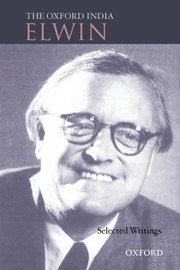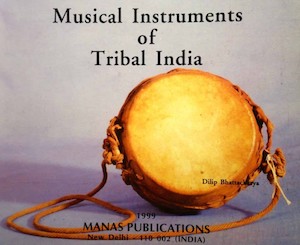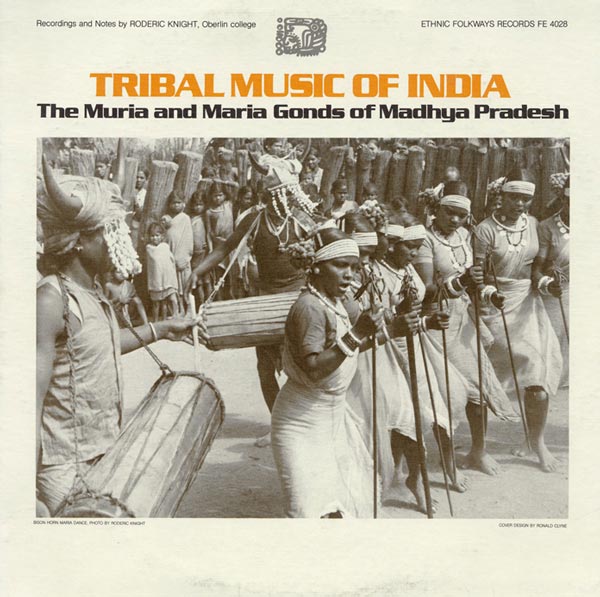Audio-resource-link: The Muria and Maria Gonds of Madhya Pradesh – audio examples and information >>
- Babiracki, C.M., ‘Tribal music in the study of great and little traditions of Indian music’. In: B. Nettl (ed.), Comparative musicology and anthropology of music. Chicago, 1990.
- Bhattachary S., 5., Ethno-musicology and India. Calcutta,1968.
- Deva, B.C., Musical instruments. Delhi, 1977.
- Deva, B.C., Kuckertz, J., ‘Songs of the Todas of the Nilgiris’. Sangeet Natak 50 (1978), p. 5-26.
- Elwin, Verrier. The Muria and their Ghotul. Bombay, 1947.
- Hivale, S., The Pardhans of the Upper Narbada Valley. Bombay, 1946.
- Jairazbhoy, N.A., A musical Journey through India. Los Angeles, 1988.
- Kaufmann, W., ‘The songs of the Hill Maria, Jhoria Muria and Bastar Muria Gond Tribes’. Ethnomusicology 4 (1960) nr. 2, p. 115-128.
- Kaufmann, W., ‘The musical instruments of the Hill Maria, Jhoria and Bastar Muria Gond tribes’. Ethnomusicology 5 (1961) nr. 1, p. 1-9.
- Knight, R. ‘The harp in India today’. Ethnomusicology 29 (1985) nr. 1, p. 9-28.
- Kothari, K.S., Indian folk musical instruments. Delhi, 1968.
- The new grove dictionary of musical instruments. Londen, 1984. Bijdragen van o.a. C. Babiracki, A. Dick en G. Dournon.
- Wolf, Richard K. The Black Cow’s Footprint: Time, Space and Music in the Lives of the Kotas of South India. Champaign: University of Illinois Press, 2006.
- Wrazen, L., ‘The early history of the Vina and Bin in South and Southeast Asia’. Asian Music 18 (1986) nr. 1, p. 35-55.
Source: Discography – information in Dutch (1992, updated by webmaster 2019) by Felix van Lamsweerde: “Muziek en muziekinstrumenten”, published in Adivasi: het andere India by Frits Cowan (ed.). Koninklijk Instituut voor de Tropen / Tropenmuseum, 1992, pp. 63-73

Learn more about Verrier Elwin: Author and educator known for his work with the tribes of India >>
Tribal communities in the central Indian region of Bastar:
Baiga | Bhatra | Dhruva | Gond | Halba | Madia | Maria | Muria
Ethnomusicologists don’t spend their time comparing the musics of different societies, and they certainly don’t compare in order to determine who is better at this or that aspect of music-making. But they look at each musical culture from a viewpoint that relates it to the world of music, a world comprised of a multitude of musical cultures that are alike in some ways and different in others, and they believe that insight can be gained from comparison. A comparative perspective, yes; but when it comes to brass tacks, what kinds of comparison are significant, and whether there is a good method for comparing musics, these are questions the literature has generally avoided.
Source: Nettl, Bruno in The Study of Ethnomusicology: Thirty-One Issues and Concepts
(University of Illinois 1983, 2005), p. 20
URL: https://www.academia.edu/4049835/
Date Visited: 24 May 2022
[Bold typeface added above for emphasis]

Musical Instruments of Tribal India
by Dilip Bhattacharya >>
See also
Audio | Santali Traditional and Fusion Songs: Ghosaldanga Bishnubati Adibasi Trust – West Bengal
Crafts and visual arts | Masks
India’s tribal, folk and devotional music: Secular and ceremonial songs
Memory of the World Programme – Unesco
Music and dance | Musicology | Adivasi music and the public stage by Jayasri Banerjee
Video | Banam lutes and fiddles of the Santal people – Jharkhand & West Bengal
Video | Celestial Dancers of Manipur
Video | Cultural traditions of the Halakki people – Karnataka
Video | Khasi musical heritage of Meghalaya
Video | Kota women’s dance: Shivaratri celebrations – Nilgiris – Tamil Nadu
Video | Santali video album “Ale Ato” (Our Village, Part 1 of 2) – West Bengal
Video | South Gujarat tribal music documentation by Bhasha – Gujarat
Video | Tribes in Transition-III: “Indigenous Cultures in the Digital Era”
Video | Safe contents for educational use on many topics (music, visual arts and more)
